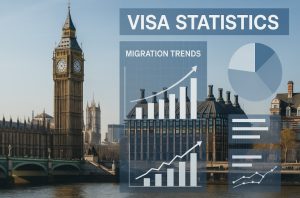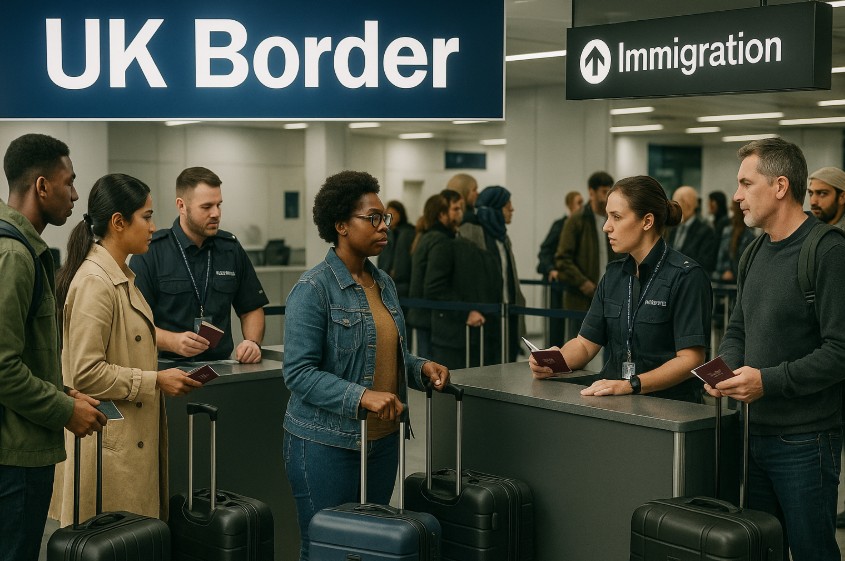The latest UK entry clearance visa applications data provides crucial insights into migration trends for work, study, and family purposes.
According to the Home Office’s provisional immigration statistics for 2025, significant shifts have occurred across major visa categories, largely due to policy changes and labour market adjustments.
These figures highlight how the UK’s evolving immigration rules continue to shape the country’s demographic and economic landscape.
What Are the UK Entry Clearance Visa Applications in 2025?

The UK entry clearance visa applications data for 2025 reveal a complex picture of how policy, economic conditions, and global mobility interact to influence migration flows. Entry clearance visas are required for those seeking to enter the UK for work, study, or family reasons. Each route reflects a different aspect of the UK’s international relationships and domestic needs.
In 2025, total visa applications have stabilised compared with the post-pandemic highs of 2022 and 2023. The tightening of immigration rules in mid-2025, especially for skilled workers and dependants, has created notable shifts across categories.
Several drivers have influenced visa application trends in 2025:
- The rise in salary thresholds and skill requirements for Skilled Worker visas.
- Restrictions on dependants accompanying students and care workers.
- Increased scrutiny of employers in health and social care sectors.
- Adjustments to family income thresholds for sponsorship.
Collectively, these changes have aimed to balance migration control with the UK’s ongoing need for workers in critical sectors such as healthcare, agriculture, and education.
Work Visa Applications – Skilled and Temporary Routes
Skilled Worker and Health & Care Worker Visas
The Skilled Worker route continues to be one of the most important channels within the UK entry clearance visa applications system. Between early 2022 and mid-2023, Health and Care Worker visas saw rapid growth due to the inclusion of care roles on the Shortage Occupation List. This enabled thousands of overseas workers to fill essential roles in hospitals and care homes.
However, by early 2024, the situation began to reverse. The Home Office intensified its compliance measures, inspecting employers to ensure they met sponsorship obligations.
Consequently, visa applications dropped sharply. From a peak of 18,300 main applicants in August 2023, numbers declined to 2,400 in March 2024 and only 700 by September 2025.
Applications for dependants also reflected this downward trend. In August 2023, 23,300 dependants were granted visas under this route. By mid-2024, following new restrictions, this number had fallen below 4,000. The fall demonstrates the direct impact of policies aimed at reducing migration through dependant limitations.
For Skilled Worker visas, monthly applications remained steady at around 6,000 between June 2022 and March 2024. There was a brief surge to over 10,000 applications in April 2024, just before the new rules were implemented. By late 2025, however, the average dropped to 2,700 per month.
Under the July 2025 policy changes, the minimum salary threshold for Skilled Worker visas increased from £38,700 to £41,700, while the qualification level rose to RQF 6 or above. Health and Care Worker visas retained their £25,000 minimum salary, but new international recruitment in care roles was suspended, limiting applications from abroad until at least 2028.
Temporary Work Routes

The UK’s temporary visa routes continue to attract applicants seeking short-term work opportunities. The Youth Mobility Scheme and Seasonal Worker visa remain the leading categories under temporary work routes.
In the year ending September 2025, 21,900 Youth Mobility Scheme applications were recorded, representing an 11% decrease compared with the previous year. This decline can be attributed to limited quotas and reduced bilateral agreements with some partner countries.
Seasonal Worker visas, which are essential for the UK’s agricultural sector, saw a modest 9% rise compared to 2024, reaching 38,900 applications. These visas are issued under an annual quota system and typically peak during the spring and summer months when demand for agricultural labour is highest.
Applicants under these categories are not permitted to bring dependants, simplifying administrative processes but restricting family migration through temporary employment routes.
Summary of Work Visa Trends (2023–2025):
| Visa Route | 2023 Applications | 2024 Applications | 2025 Applications | % Change (2023–2025) |
| Skilled Worker (main applicants) | 6,000 per month | 10,100 (Apr 2024) | 2,700 (Sept 2025) | -55% |
| Health & Care Worker (main applicants) | 18,300 (Aug 2023) | 2,400 (Mar 2024) | 700 (Sept 2025) | -96% |
| Youth Mobility Scheme | 24,600 | 24,000 | 21,900 | -11% |
| Seasonal Worker | 35,700 | 36,000 | 38,900 | +9% |
This data shows a sharp decline in permanent work routes but stability in short-term employment categories. The contrast highlights the effect of policy tightening in long-term migration routes while maintaining flexibility for temporary labour.
Study Visa Applications – The Impact of Policy Shifts
The UK’s education sector continues to attract international students despite the government’s renewed focus on migration control. Sponsored study visas follow consistent seasonal patterns, peaking every August and December in preparation for new academic terms.
In the year ending September 2025, 434,600 applications were made for sponsored study visas. This figure is 7% higher than in 2024 but still 13% below the record levels seen in 2023. The decline is mainly attributed to new restrictions on dependants introduced in January 2024.
The policy allows only postgraduate researchers and students on government-funded scholarships to bring dependants. As a result, dependant visa applications dropped from over 150,000 in 2023 to just 22,500 in 2025, an 85% reduction.
Key trends in the study visa category include:
- Continued dominance of applicants from India, China, and Nigeria.
- Reduced interest from older and family-oriented applicants.
- Growth in applications from countries participating in academic exchange programmes.
The decrease in dependant applications has also affected housing demand and local economies in university towns, where families previously contributed to the community through longer stays and spending.
Study Visa Applications Overview (2023–2025):
| Category | 2023 Applications | 2024 Applications | 2025 Applications | % Change |
| Sponsored Study (main applicants) | 500,000 | 470,000 | 434,600 | -13% |
| Student Dependants | 150,000+ | 40,000 | 22,500 | -85% |
While the total number of student visas remains strong, universities are expected to adjust their recruitment strategies to sustain international enrolment amid policy challenges.
Family Visa Applications – Balancing Policy and Demand

Family visa applications have experienced significant fluctuations since late 2023. When the government announced plans to raise income requirements for family sponsorship, many families rushed to apply before the new rules took effect.
Applications rose from 7,500 in December 2023 to 12,700 in April 2024. Following the implementation of the new policy, which increased the minimum income requirement, the number fell sharply to 5,100 in June 2024. By September 2025, however, applications had gradually recovered to around 8,400 per month.
The tightening of financial requirements has made it harder for some families to reunite, particularly those with sponsors in lower-income regions of the UK. Public feedback and advocacy groups have expressed concerns about fairness and the social impact of separating families.
In September 2025, the Refugee Family Reunion route was temporarily paused, meaning those affected must apply through other family visa pathways if they meet the criteria.
These shifts highlight the delicate balance between maintaining immigration control and supporting social cohesion. The gradual recovery in application numbers suggests that despite stricter financial thresholds, the demand for family reunification remains strong.
What Are the Key Policy Changes Affecting Visa Applications in 2025?

The Home Office’s Restoring Control over the Immigration System white paper, published in May 2025, introduced sweeping reforms across multiple visa categories. The measures took effect on 22 July 2025 and had immediate consequences for application numbers.
Key provisions include:
- Raising the minimum salary for Skilled Workers from £38,700 to £41,700.
- Increasing the required skill level to RQF 6, limiting eligibility for mid-level jobs.
- Maintaining the £25,000 salary threshold for Health and Care Workers but ending new overseas recruitment.
- Restricting dependants for both care workers and international students.
- Revising income thresholds for family sponsorship applications.
Employers and educational institutions have had to adjust their recruitment strategies in response. Many sectors, including healthcare and hospitality, have reported challenges in filling vacancies, while universities have noted a reduction in postgraduate applicants with families.
The combined effect of these changes is a visible contraction in long-term migration routes alongside a moderate rise in temporary and family visa categories.
Conclusion
The 2025 statistics on UK entry clearance visa applications illustrate a period of significant transition. Policy reforms aimed at reducing overall migration have effectively curbed applications in key employment routes. However, the UK still faces the challenge of maintaining workforce supply in essential sectors, particularly health and social care.
As the Home Office continues to refine immigration rules, the balance between economic demand, educational excellence, and family unity remains at the heart of the debate. Future policy developments will determine whether the UK can uphold its reputation as a leading destination for skilled professionals, international students, and families alike.
Frequently Asked Questions (FAQs)
What is the purpose of UK entry clearance?
Entry clearance is the official permission granted to individuals who intend to enter the UK for work, study, or family reasons before travelling.
How have Skilled Worker visa rules changed in 2025?
The required skill level has been raised to RQF Level 6, and the minimum salary threshold increased to £41,700, except for roles on the Immigration Salary List.
Why have Health and Care Worker visa applications declined?
Applications have dropped due to new restrictions on overseas recruitment and increased compliance checks for UK employers.
Can students still bring dependants to the UK?
Most students cannot bring dependants unless they are studying a postgraduate research course or are sponsored by a government scholarship.
What caused the rise in Family visa applications in early 2024?
The surge was due to families applying ahead of the announced increase in income requirements for sponsorship.
Are temporary work visa routes affected by policy changes?
Temporary routes like the Youth Mobility Scheme and Seasonal Worker visas remain largely unaffected but are limited by annual quotas.
Where can I access official UK visa application statistics?
Provisional and final statistics are published quarterly by the UK Home Office under the Immigration System Statistics releases.








